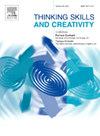Relative age effect in creativity development: A longitudinal investigation
IF 3.7
2区 教育学
Q1 Social Sciences
引用次数: 0
Abstract
The Relative Age Effect (RAE) refers to the age differences between children within the same cohort or school year and the resulting impact on their development. The present longitudinal study aimed to investigate the presence of the RAE in the development of synthetic creative abilities among eight-year-old children (N = 286). The children's synthetic creative abilities were measured four times, in the 2nd and 3rd grades of elementary school, at six-month intervals, using the Test of Creative Thinking-Drawing Production. We tested two main hypotheses: (1) relatively older students would exhibit higher levels of synthetic creative abilities compared to their younger peers, and (2) the RAE would decrease as students progress through their school years. The results confirmed the presence of the RAE, with relatively older students consistently demonstrating higher creativity. The disparity in synthetic creative abilities between relatively older and younger students persisted over time. The study highlights the need for further research to better understand the long-term effects of the RAE on creativity.
创造力发展的相对年龄效应:一项纵向调查
相对年龄效应(RAE)指的是同一队列或同一学年的儿童之间的年龄差异及其对其发展的影响。本研究旨在探讨八岁儿童综合创造能力发展中RAE的存在。孩子们的综合创造能力在小学二年级和三年级进行了四次测试,每隔六个月进行一次,使用创造性思维-绘画生产测试。我们测试了两个主要假设:(1)相对年龄较大的学生比他们的同龄人表现出更高水平的综合创造能力;(2)随着学生在学校的进步,RAE会下降。结果证实了RAE的存在,年龄相对较大的学生始终表现出更高的创造力。随着时间的推移,年龄相对较大的学生和年龄相对较小的学生在综合创造能力方面的差异持续存在。这项研究强调了进一步研究的必要性,以更好地了解RAE对创造力的长期影响。
本文章由计算机程序翻译,如有差异,请以英文原文为准。
求助全文
约1分钟内获得全文
求助全文
来源期刊

Thinking Skills and Creativity
EDUCATION & EDUCATIONAL RESEARCH-
CiteScore
6.40
自引率
16.20%
发文量
172
审稿时长
76 days
期刊介绍:
Thinking Skills and Creativity is a new journal providing a peer-reviewed forum for communication and debate for the community of researchers interested in teaching for thinking and creativity. Papers may represent a variety of theoretical perspectives and methodological approaches and may relate to any age level in a diversity of settings: formal and informal, education and work-based.
 求助内容:
求助内容: 应助结果提醒方式:
应助结果提醒方式:


